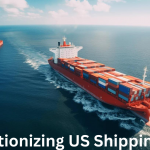The rapid rise of e-commerce has dramatically transformed the way consumers shop, leading to significant shifts in how goods are transported and delivered. With the U.S. retail e-commerce market expected to continue its exponential growth, this transformation has reshaped the entire shipping and logistics industry. Online retail has forced shipping companies, retailers, and logistics providers to adapt to new consumer expectations, adjust their delivery infrastructures, and embrace new technologies to stay competitive. This article delves into the profound impact of e-commerce on U.S. shipping, outlining both the challenges and opportunities that have arisen.
The E-commerce Boom
The growth of e-commerce in the U.S. has been nothing short of explosive. Online shopping platforms such as Amazon, Walmart, and Shopify have revolutionized the consumer experience, offering unprecedented convenience, choice, and speed. According to data from the U.S. Department of Commerce, e-commerce sales in the U.S. surpassed $1 trillion in 2022, and the trend shows no signs of slowing down.
The convenience of online shopping has led to an increased demand for quick and reliable delivery services. With consumers now expecting their purchases to arrive within a matter of days, or even hours in some cases, shipping companies and logistics providers have had to dramatically rethink their operations to meet these new expectations.
Changes in Consumer Behavior and Expectations
As e-commerce has grown, so too have consumer expectations. Customers now expect fast, flexible, and often free shipping options. This “Amazon Effect,” named after the online retail giant’s pioneering delivery model, has led to increased pressure on shipping companies to shorten delivery times, improve tracking transparency, and reduce costs. Two-day shipping, once a premium offering, is now considered standard, and same-day or even two-hour delivery is becoming increasingly popular.
This shift has caused a ripple effect across the shipping and logistics industry. Traditional shipping models that were designed to move large quantities of goods to retail locations have had to adapt to a model where individual packages are sent directly to customers’ homes. This has led to a dramatic increase in the volume of small, single-item shipments, creating new logistical challenges.
Growth in Last-Mile Delivery
One of the most significant challenges posed by the rise of e-commerce is last-mile delivery, which refers to the final step in the shipping process when goods are delivered to the customer’s doorstep. Last-mile delivery is often the most expensive and logistically complex part of the shipping process, accounting for up to 53% of total shipping costs. The rise of e-commerce has only exacerbated these challenges, as shipping companies now need to manage a greater number of individual deliveries across dispersed geographic areas.
To cope with the surge in demand for last-mile delivery, many shipping companies have turned to new strategies and technologies. Some have expanded their own delivery networks, while others have partnered with third-party logistics providers to increase their reach. Additionally, innovations such as drones, autonomous delivery vehicles, and crowdsourced delivery platforms like Postmates and DoorDash are being explored as potential solutions to the last-mile challenge.
The Role of Technology in U.S. Shipping
The rise of e-commerce has brought about a wave of technological innovation in the shipping industry. To meet the growing demands for faster, more efficient delivery services, shipping companies are increasingly adopting advanced technologies that improve operational efficiency and customer satisfaction.
- Automation: Automation is playing an increasingly important role in shipping and logistics, particularly in warehouses and fulfillment centers. Robotic systems and AI-powered algorithms are being used to streamline order picking, packing, and sorting, significantly reducing labor costs and improving accuracy.
- Real-time Tracking: Consumers now expect to be able to track their packages in real-time from the moment they make a purchase until it arrives at their door. This has led to widespread adoption of advanced tracking systems that provide real-time updates to both consumers and logistics providers.
- Artificial Intelligence (AI) and Machine Learning: AI and machine learning are being used to optimize shipping routes, predict demand patterns, and improve inventory management. These technologies help shipping companies reduce costs, minimize delivery times, and ensure more accurate order fulfillment.
- Drones and Autonomous Vehicles: While still in the early stages of development, drones and autonomous delivery vehicles hold significant potential for the future of last-mile delivery. Companies like Amazon and Google are investing heavily in drone technology, with the goal of providing faster and more efficient delivery services.
- Sustainability Efforts: With the increase in e-commerce shipping, there is also growing concern about the environmental impact of increased deliveries. Many companies are investing in more sustainable shipping practices, such as electric delivery vehicles, carbon-neutral shipping programs, and more efficient packaging solutions to reduce waste.
Challenges for U.S. Shipping Companies
While the e-commerce boom has presented opportunities for growth, it has also brought significant challenges to the U.S. shipping industry.
- Increased Shipping Volumes: The sheer volume of packages being shipped as a result of e-commerce growth has put immense pressure on shipping companies. During peak shopping seasons like Black Friday and Cyber Monday, shipping volumes can surge dramatically, leading to capacity constraints and delayed deliveries.
- Rising Costs: Meeting the demand for faster and more frequent deliveries has driven up shipping costs, particularly for last-mile delivery. Free shipping, which has become a standard offering for many online retailers, further eats into profit margins. Shipping companies are constantly seeking ways to balance cost-efficiency with speed and customer satisfaction.
- Labor Shortages: The growing demand for fast delivery has also increased the need for workers in warehouses, fulfillment centers, and delivery networks. However, labor shortages in the logistics industry have made it difficult for companies to keep up with the increasing demand for labor.
- Infrastructure Strain: E-commerce growth has put significant strain on existing transportation and delivery infrastructures. Urban areas, in particular, have struggled to keep up with the influx of delivery vehicles, leading to increased traffic congestion, parking challenges, and delivery inefficiencies.
Opportunities for Growth
Despite the challenges, the rise of e-commerce has created numerous growth opportunities for U.S. shipping companies.
- Expanded Service Offerings: Shipping companies have the opportunity to expand their service offerings to meet the needs of e-commerce retailers. This includes providing enhanced tracking, offering faster delivery options, and developing new solutions for last-mile delivery.
- Collaboration with Retailers: E-commerce growth has led to increased collaboration between shipping companies and online retailers. By working together, both parties can optimize their supply chains and improve delivery efficiency.
- Investment in Innovation: The ongoing need for faster and more efficient delivery solutions has spurred significant investment in logistics technologies. This includes advancements in automation, AI, and alternative delivery methods like drones.
Conclusion
The impact of e-commerce on U.S. shipping is profound and far-reaching. As consumers increasingly turn to online shopping, shipping companies have had to adapt to new expectations, technologies, and operational models. While the e-commerce boom has introduced significant challenges—particularly in terms of last-mile delivery and cost management—it has also presented new opportunities for growth and innovation. Going forward, the shipping industry will continue to evolve alongside the e-commerce landscape, embracing new technologies and strategies to meet the demands of the modern consumer.
FAQs
1. How has e-commerce changed the U.S. shipping industry?
E-commerce has dramatically transformed the U.S. shipping industry by increasing the volume of packages shipped, changing consumer expectations for delivery speed, and creating a demand for more flexible and convenient shipping options. Shipping companies have had to adapt by improving last-mile delivery capabilities, adopting new technologies, and offering faster services to keep up with the surge in online shopping.
2. What is last-mile delivery, and why is it important?
Last-mile delivery refers to the final step of the shipping process, where goods are delivered from a distribution center to the customer’s doorstep. It is important because it accounts for a significant portion of shipping costs and has a direct impact on customer satisfaction. The rise of e-commerce has increased the complexity and cost of last-mile delivery, leading companies to invest in new solutions to make it more efficient.
3. How has consumer behavior influenced the shipping industry?
Consumer behavior has shifted with the growth of e-commerce, leading to increased demand for fast, free, and convenient shipping options. Customers now expect shorter delivery times, real-time tracking, and more flexibility, such as same-day or two-hour delivery windows. This has forced shipping companies to prioritize speed and transparency in their delivery services.
4. What is the “Amazon Effect”?
The “Amazon Effect” refers to the impact that Amazon’s fast, reliable, and often free shipping has had on consumer expectations and the broader shipping industry. Amazon’s ability to offer two-day or even same-day shipping as a standard has set a new benchmark for delivery times, pushing other retailers and shipping companies to provide similar services to remain competitive.

